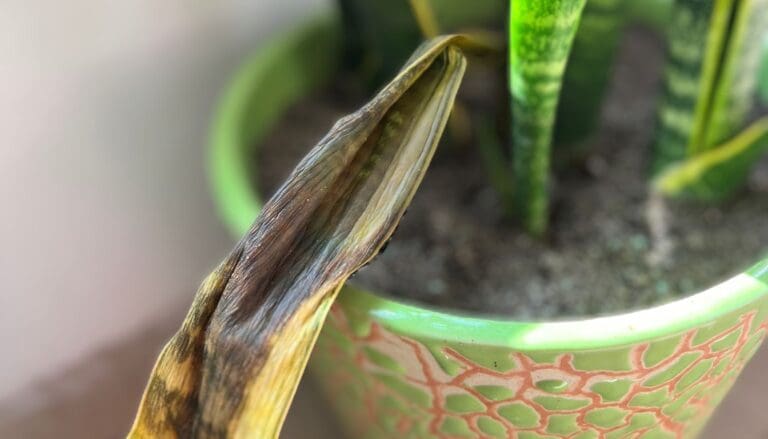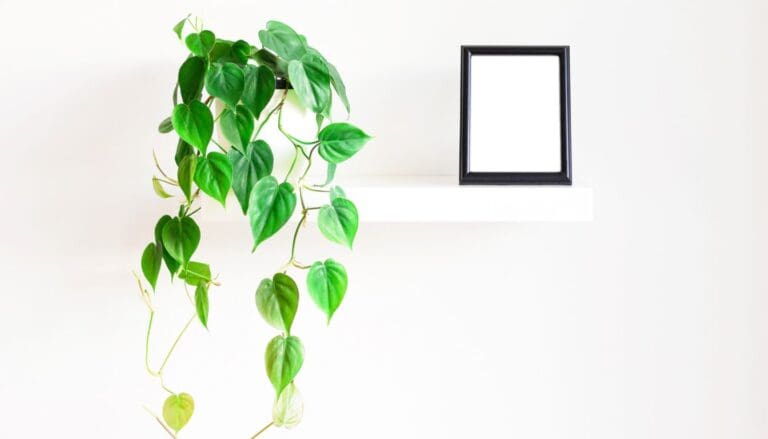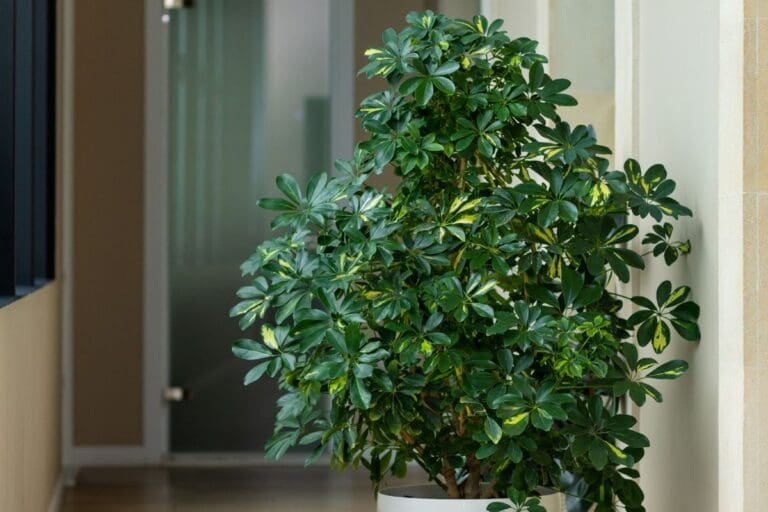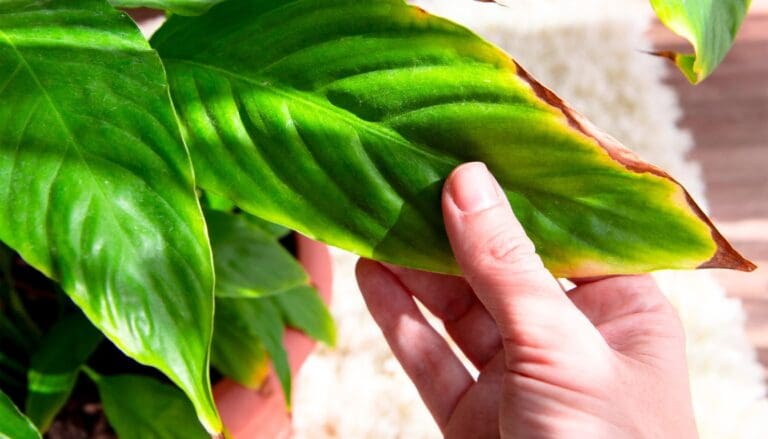Arrowhead Plant Temperature Tolerance: Hot, Cold & Ideal Temperature
Arrowhead plants or Syngonium are tropical plants that climb as they mature and have unique spade-shaped foliage. If you plan to get this plant for your house, you might want to know the temperature tolerance of this species.
Arrowhead plants cannot tolerate temperatures below 50°F or above 90°F. The ideal temperature range for these plants comes between 60-85°F. Extreme temperatures can cause severe damage to your Syngonium, so we must protect the plant from such situations.
This article will look into the temperature tolerance of arrowhead plants and how you can protect them from hot or cold temperatures.
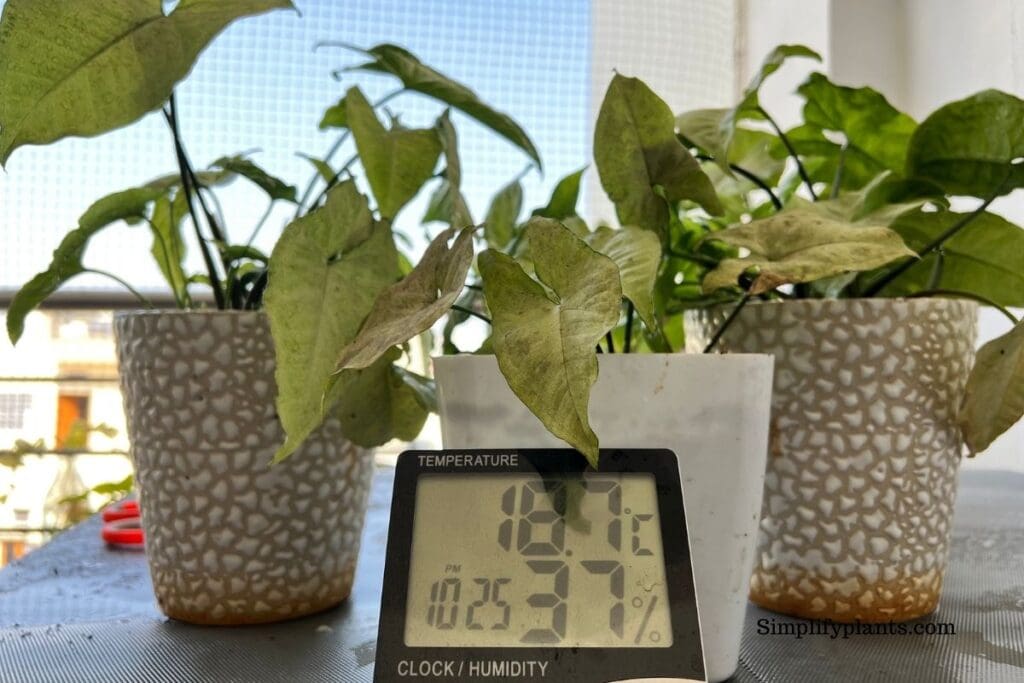
Please note: Simplify Plants is reader-supported. Some links in the post are affiliate links and I get a commission from purchases made through links in the post.
How cold can Arrowhead plants tolerate?
Arrowhead plants come from tropical and subtropical regions where they are used to warm conditions.
These plants prefer warm temperatures and high humidity levels, and to keep them happy, you must try to mimic their native environment.
This brings us to the fact that arrowhead plants will not enjoy low temperatures.
Temperatures below 50°F are too cold for your arrowheads.
If you don’t protect your Syngonium from the low temperatures, especially during winter, you will notice significant damage.
Can I put my Arrowhead Plant outside?
You can put your arrowhead plant outside if the temperature and humidity levels are suitable for the plant.
Since arrowheads are sensitive to lower temperatures, you must not take them outside if your area experiences temperatures below 50 degrees.
You can take your arrowhead plant outside if you live in USDA hardiness zones 10 and 11.
The temperatures will be too harsh for this species in any other region.
Also read: Can Arrowhead Plants Grow Outside? (Outdoor Care+Bringing Them In)
When should I bring my arrowhead plant inside?
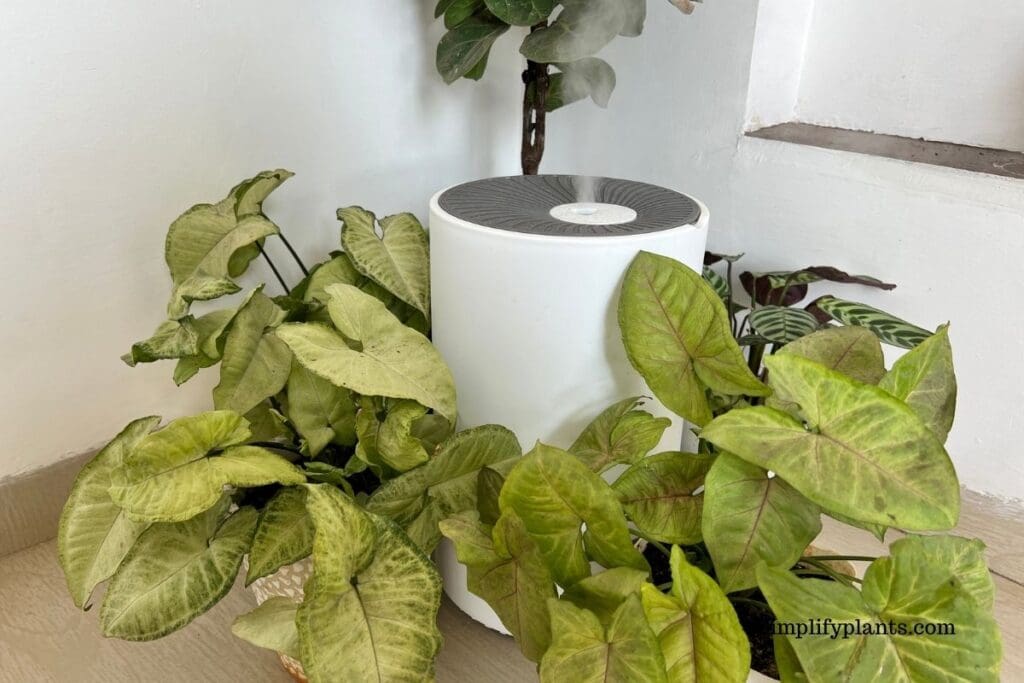
If you have placed your arrowhead plant outside, you must know when to bring it inside.
If you don’t bring the plant inside on time, it will experience frost or low temperatures that can cause irreversible damage to your dear plant.
You should bring your Syngonium inside when summer comes to an end.
Don’t think of taking the plant outside during winter.
Let it remain in a warm room inside the house.
What is the ideal temperature for arrowhead plants?
Since arrowhead plants come from tropical regions, they prefer warm temperatures.
The ideal temperature for arrowhead plants is 60-85°F.
You should protect your arrowhead plant from low temperatures below 50°F.
You should also not expose it to temperatures above 85-90°F.
It can happen if you expose the plant to direct sunlight or keep it near any heating source, so avoid doing that.
Let’s look at how low and high temperatures affect your arrowhead plant.
Effects of low temperature on arrowhead plants

If you expose your arrowhead plant to temperatures below 50°F, you will notice:
- Yellow leaves
- Falling leaves
- Black leaves
- Brown spots on leaves
- Stunted growth
Low temperatures can make your plant weak and even cause the death of your plant if you keep neglecting it.
If your arrowhead underwent a cold shock, here is what you need to do to help it recover.
- Bring your arrowhead plant indoors if it was placed outside.
- Prune the foliage and stems that got damaged due to the low temperatures.
- Keep your arrowhead in a warm room where it doesn’t receive low temperatures.
- Avoid watering the plant with freezing water.
- Since damages from low temperatures are severe, the plant will take some time to recover.
But, if you want to protect your Syngonium from the harmful effects of low temperatures, keep these in mind.
- Don’t keep your arrowhead outside during winter.
- Find a warm spot for your arrowhead where it will get suitable temperatures.
- Don’t place the plant close to frosty windows.
- Provide bright indirect sunlight to your arrowhead.
- Avoid placing it near windows or doors that are closed and opened frequently.
Effects of high temperature on arrowhead plants

Like low temperatures, high temperatures are also damaging for the arrowhead plant.
Your arrowhead might get stressed if you expose it to direct sunlight or keep it too close to heating sources like radiators or fireplaces.
If your arrowhead is affected by high temperatures, you will notice:
- Leaves turning brown at the edges
- Lower leaves falling off
- Wilting leaves
- Dry and crispy foliage
- Scorched leaves
If you notice these signs on your arrowhead plant, you should take the following steps.
- Relocate the plant to a spot where it does not receive excess warmth.
- Prune the dried and damaged foliage.
- Give the plant a good soak of water to help it recover.
- Always use room temperature water to avoid stressing your Syngonium.
If you want to protect your arrowhead plant from high temperatures, consider the following points.
- If you want to place your arrowhead plant outside, find a shady spot where the plant will not receive direct sunlight.
- Indoors, you can find a spot that receives room temperature and place your arrowhead there.
- Don’t keep your arrowhead plant too close to any heating sources.
Can arrowhead plants survive winter?
Arrowhead plants will survive winter as long as you provide proper care to the plant and don’t expose it to harsh conditions.
Arrowhead plants are indoor plants as they are not suitable for low temperatures outside.
So, when winter arrives, you must bring your arrowhead indoors if it isn’t already.
After bringing the plant indoors, don’t keep it anywhere but find the correct spot with warm conditions, sufficient humidity, and not low temperatures.
Don’t place the plant near frosty windows.
The arrowhead will require slightly different care from the summer or spring seasons during winter.
How to take care of the arrowhead plant in the summer and winter?

Let’s look at the difference between the care routine of the arrowhead plant during summer when the temperatures are highest and winter when temperatures fall drastically.
| Factor | Summer Care | Winter Care |
|---|---|---|
| Light | Place your arrowhead near a bright window but keep it a few feet away or use curtains to protect it from the direct sun. | You can expose the arrowhead to the direct morning sun for 1-2 hours in the morning as the intensity remains low. You can use artificial lights if the plant doesn’t get enough light or warmth. |
| Water | Water your arrowhead once a week, only after ensuring it needs the water. The soil should be 50-75% dry. | The soil takes longer to dry during winter, and the plant functions slowly. So it will require less watering. You can water once in 2-3 weeks after checking the soil. |
| Fertilizer | You should fertilize your arrowhead once a month with diluted liquid fertilizer during summer and spring. | In winter, you should stop fertilizing as the plant doesn’t require it. |
| Repotting | This is the ideal time to repot your arrowhead if it needs repotting. The ideal growing conditions will allow it to recover from the repotting stress. | Avoid repotting during winter unless it is urgent. The conditions are not ideal, which might stress the arrowhead. |
| Placement | You can place your arrowhead plant outside but find a spot guarded against direct sunlight. | You must bring your Syngonium inside instead of leaving it outside as the low temperatures can damage the plant. |
| Humidity | You can group your arrowhead with moisture-loving plants or use a humidifier to maintain the humidity. | In winter, humidity levels drop low, so you can still use the humidifier or group your arrowhead to provide moisture. You can mist the plant also if the air feels too dry. |
Can arrowhead plants survive in air-conditioned rooms?
Arrowhead plants will do well in air-conditioned rooms if you don’t keep them opposite the AC.
The air that comes out of the AC is dry and cold.
This can be very harmful to your Syngonium as it robs moisture from your plant and exposes it to low temperatures.
I will not recommend keeping your arrowhead in an air-conditioned room unless you have to because the conditions are not the best for these tropical species.
But if you have no other choice, make sure you keep your arrowhead far away from the AC and provide it with enough water and humidity, so it doesn’t get stressed.
If there’s a window, try placing your arrowhead near it as it gets enough indirect light and some warmth.
If you don’t have a humidifier, you can mist your arrowhead to provide moisture.
If your arrowhead doesn’t react well after staying in an air-conditioned room, try to relocate it to a more warm and humid spot.
Final words
Arrowhead plants are tropical houseplants that prefer warm conditions and will not enjoy temperatures beyond or below their ideal range. The ideal temperature range for Syngoniums is 60-85 degrees.
If you want to keep your arrowhead healthy, you must protect it from extremely low and high temperatures. Avoid exposing the plant to temperatures below 50 degrees or above 85-90 degrees.
You must be extra careful during winters as the temperatures tend to go low, and the plant might get a cold shock if you don’t place it at the right spot. Also, ensure that your arrowhead is getting sufficient humidity.
Reference: CABI, Britannica, United States Department of Agriculture, Wikipedia, Children’s Health Queensland Hospital and Health Service, Missouri Botanical Garden.
Recommended Garden Supplies
| Product Image | Our Recommended Gardening Supplies | Check Offers! |
|---|---|---|
Top Top
Top
Top
Top
Top
Top
Top
Top | rePotme Houseplant and Tropical Classic Potting Soil Mix | Check Offer On Amazon |
 Top
Top
Top
Top
Top
Top
Top
Top | Espoma Organic Indoor Plant Food | Check Offer On Amazon |
 Top
Top
Top
Top
Top
Top
Top
Top | GooingTop LED Grow Light 6000K Full Spectrum Clip Plant Growing Lamp | Check Offer On Amazon |
 Top
Top
Top
Top
Top
Top
Top
Top | Soil Moisture Meter | Check Offer On Amazon |
 Top
Top
Top
Top
Top
Top
Top
Top | Govee Hygrometer Thermometer, Bluetooth Enabled! | Check Offer On Amazon |
 Top
Top | LEVOIT Humidifiers for Large Room(Best For Plants) | Check Offer On Amazon |
 Top
Top
Top
Top
Top
Top
Top
Top | Upgraded DIY Automatic Drip Irrigation Kit, 15 Potted Houseplants Support | Check Offer On Amazon |
 Top
Top
Top
Top
Top
Top
Top
Top | Stainless Steel Heavy Duty Gardening Tool Set | Check Offer On Amazon |
 Top
Top
Top
Top
Top
Top
Top
Top | Bonide Insecticidal Soap | Check Offer On Amazon |
 Top
Top
Top
Top
Top
Top
Top
Top | Bonide 32 oz Spray Neem Oil for Organic Gardening | Check Offer On Amazon |
 Top
Top
Top
Top
Top
Top
Top
Top | Garden Safe Fungicide | Check Offer On Amazon |

